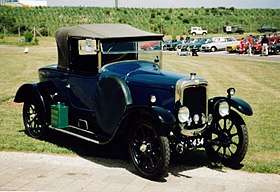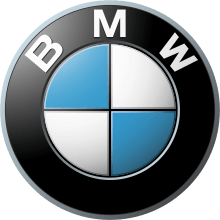Triumph Motor Company
The Triumph Motor Company was a British car and motor manufacturing company in the 19th and 20th centuries. The marque had its origins in 1885 when Siegfried Bettmann of Nuremberg formed S. Bettmann & Co. and started importing bicycles from Europe and selling them under his own trade name in London. The trade name became "Triumph" the following year, and in 1887 Bettmann was joined by a partner, Moritz Schulte, also from Germany. In 1889, the businessmen started producing their own bicycles in Coventry, England.
 | |
| Fate | Acquired by Leyland Motors (1960) marque retired (1984) marque acquired by BMW (1994) |
|---|---|
| Founded | 1885 (as S. Bettmann & Co. Import Export Agency) |
| Defunct | 1984 |
| Headquarters | Coventry, England |
Key people | Siegfried Bettmann, Moritz (founders) |
| Parent | Standard Motors Ltd, Leyland Motors Ltd., British Leyland Motor Corporation Ltd, BL plc |
The company was acquired by Leyland Motors in 1960, ultimately becoming part of the giant conglomerate British Leyland (BL) in 1968, where the Triumph brand was absorbed into BL's Specialist Division alongside former Leyland stablemates Rover and Jaguar. Triumph-badged vehicles were produced by BL until 1984 when the Triumph marque was retired, where it remained dormant under the auspices of BL's successor company Rover Group. The rights to the Triumph marque are currently owned by BMW, who purchased the Rover Group in 1994.

Triumph car models
Pre-war
| Model Name | Engine | Year |
|---|---|---|
| Triumph 10/20 | 1393 cc inline 4 | (1923–1925) |
| Triumph 13/35 or 12.8 | 1872 cc inline 4 | (1927–1927) |
| Triumph 15/50 or Fifteen | 2169 cc inline 4 | (1926–1930) |
| Triumph Super 7 | 747 cc inline 4 | (1928) |
| Triumph Super 8 | 832 cc inline 4 | (1930) |
| Triumph Super 9 | 1018 cc inline 4 | (1931) |
| Triumph Gloria 10 | 1087 cc inline 4 | (1933) |
| Triumph 12-6 Scorpion | 1203 cc inline 6 | (1931–1933) |
| Triumph Southern Cross | 1087/1232 cc inline 4 | (1932) |
| Triumph Gloria ('12' / '12') Four | 1232/1496 cc inline 4 | (1934–1937) |
| Triumph Gloria ('6' / '6/16') Six | 1476/1991 cc inline 6 | (1934–1935) |
| Triumph Gloria 14 | 1496/1767 cc inline 4 | (1937–1938) |
| Triumph Dolomite 8 | 1990 cc inline 8 (DOHC) | (1934) |
| Triumph Dolomite Vitesse 14 | 1767/1991 cc inline 4/6 | (1937–1938) |
| Triumph Vitesse | 1767/1991 cc inline 4/6 | (1935–1938) |
| Triumph Dolomite 14/60 | 1767/1991 cc inline 4/6 | (1937–1939) |
| Triumph Dolomite Roadster | 1767/1991 cc inline 4/6 | (1937–1939) |
| Triumph 12 | 1496 cc inline 4 | (1939–1940) |
Post war
| Model name | Engine | Year | Number built |
|---|---|---|---|
| Triumph 1800 Saloon | 1776 cc inline 4 | 1946–1949 | |
| Triumph 1800 Roadster | 1776 cc inline 4 | 1946–1948 | |
| Triumph 2000 Saloon | 2088 cc inline 4 | 1949 | |
| Triumph 2000 Roadster | 2088 cc inline 4 | 1948–1949 | |
| Triumph Renown | 2088 cc inline 4 | 1949–1954 | |
| Triumph Mayflower | 1247 cc inline 4 | 1949–1953 | |
| Triumph TR1 / 20TS | 2208 cc inline 4 | 1950 | 1 (prototype) |
| Triumph TR2 | 1991 cc inline 4 | 1953–1955 | 8,636[8] |
| Triumph TR3 | 1991 cc inline 4 | 1956–1958 | |
| Triumph TR3A | 1991 cc inline 4 | 1958–1962 | |
| Triumph TR3B | 2138 cc inline 4 | 1962 | |
| Triumph Italia | 1991 cc inline 4 | 1959–1962 | |
| Triumph TR4 | 2138 cc inline 4 | 1961–1965 | |
| Triumph TR4A | 2138 cc inline 4 | 1965–1967 | |
| Triumph TR5 | 2498 cc inline 6 | 1967–1968 | 1161 UK Spec |
| Triumph TR250 | 2498 cc inline 6 | 1967–1968 | |
| Triumph Dove GTR4 | 2138 cc inline 4 | 1961–1964 | |
| Triumph TR6 | 2498 cc inline 6 | 1969–1976 | |
| Triumph TR7 | 1998 cc inline 4 | 1975–1981 | |
| Triumph TR8 | 3528 cc V8 | 1978–1981 | |
| Triumph Spitfire 4 (Spitfire Mk I) | 1147 cc inline 4 | 1962–1965 | 45,763[9] |
| Triumph Spitfire Mk II | 1147 cc inline 4 | 1965–1967 | 37,409[9] |
| Triumph Spitfire Mk III | 1296 cc inline 4 | 1967–1970 | 65,320[9] |
| Triumph Spitfire Mk IV | 1296 cc inline 4 | 1970–1974 | 70,021[9] |
| Triumph Spitfire 1500 | 1493 cc inline 4 | 1974–1980 | 95,829[9] |
| Triumph GT6 | 1998 cc inline 6 | 1966–1973 | 40,926[9] |
| Triumph Herald | 948 cc inline 4 | 1959–1964 | |
| Triumph Herald 1200 | 1147 cc inline 4 | 1961–1970 | |
| Triumph Herald 12/50 | 1147 cc inline 4 | 1963–1967 | |
| Triumph Herald 13/60 | 1296 cc inline 4 | 1967–1971 | |
| Triumph Courier | 1147 cc inline 4 | 1962–1966 | |
| Triumph Vitesse 6 | 1596 cc inline 6 | 1962–1966 | |
| Triumph Vitesse Sports 6 (US version of Vitesse 6) | 1596 cc inline 6 | 1962–1964 | |
| Triumph Vitesse 2-litre and Vitesse Mark 2 | 1998 cc inline 6 | 1966–1971 | |
| Triumph 1300 | 1296 cc inline 4 | 1965–1970 | |
| Triumph 1300 TC | 1296 cc inline 4 | 1967–1970 | |
| Triumph 1500 | 1493 cc inline 4 | 1970–1973 | |
| Triumph 1500 TC | 1493 cc inline 4 | 1973–1976 | |
| Triumph Stag | 2997 cc V8 | 1971–1977 | |
| Triumph Toledo | 1296 cc inline 4 | 1970–1978 | |
| Triumph Dolomite 1300 | 1296 cc inline 4 | 1976–1980 | |
| Triumph Dolomite 1500 | 1493 cc inline 4 | 1976–1980 | |
| Triumph Dolomite 1500 HL | 1493 cc inline 4 | 1976–1980 | |
| Triumph Dolomite 1850 | 1850 cc inline 4 | 1972–1976 | |
| Triumph Dolomite 1850 HL | 1850 cc inline 4 | 1976–1980 | |
| Triumph Dolomite Sprint | 1998 cc inline 4 | 1973–1980 | |
| Triumph 2000 Mk1, Mk2, TC | 1998 cc inline 6 | 1963–1977 | |
| Triumph 2.5 PI Mk1, Mk2 | 2498 cc inline 6 | 1968–1975 | |
| Triumph 2500 TC & S | 2498 cc inline 6 | 1974–1977 | |
| Triumph Acclaim | 1335 cc inline 4 | 1981–1984 | 133,625[10] |
Prototypes
- Triumph TR7 Sprint
- Triumph Fury
- Triumph Lynx
Triumph-based models
| Vale Special | (1932–1936) very low built two-seater based on Super 8 and Gloria |
| Swallow Doretti | (1954–1955) |
| Amphicar | (1961–1968) used a Triumph Herald engine |
| Bond Equipe GT | (1964–1967) |
| Susita 12 | (1968–1970) Made in Israel car, manufactured by Israeli Autocars Company LTD. The Susita 12 station wagon, and sedan (named Carmel), used the Triumph Herald 12/50 engine. |
| Susita 13/60 | (1970–1975) Made in Israel car, manufactured by Israeli Autocars Company LTD. Manufactured as 2 doors station wagon, sedan (named Carmel Ducas), and pick-up versions. Built on the Triumph Herald's chassis, and used the Herald 13/60 engine and gearbox. |
| Panther Rio | (1975–1977) based on the Triumph Dolomite |
| Fairthorpe Cars | |
| Saab 99 | used Triumph slant-four engine before the parent company Scania developed its own version of it. |
| Lotus Seven | (1960–1968) the Series 2 had many Standard Triumph parts. |
| Daimler SP250 | used various Triumph parts in its gearbox and suspension,[11] gearbox was a copy of a Triumph unit.[12] |
| Jensen-Healey | Mk. I used TR-6 front brakes. |
| MG Midget 1500 | (1975–1979) Rubber-bumpered Midgets used the 1493cc L-4 and gearbox borrowed from the Triumph Spitfire. |
| Triumph Italia | (1959–1962) Designed by Giovanni Michelotti, the TR3 chassis and mechanical components were supplied by the Triumph Motor Company in the United Kingdom, and built by Alfredo Vignale in Turin, Italy. |
Badging
Globe
Pre-war Triumphs carried a stylised Globe badge, usually on the radiator grille, and this was also used on the first three models produced under Standard's control.
Griffin
Standard had introduced a new badge in 1947 for their own models, first seen on the Vanguard, a highly stylised motif based on the wings of a Griffin.[13] With the introduction of the TR2, a version of this badge appeared for the first time on the bonnet of a production Triumph, while the Globe continued to appear on the hubcaps. This same double-badging also appeared on the TR3 and TR4, the 2000 and the 1300.
However, the original Herald, Spitfire, Vitesse and GT6 models all carried only the Griffin badge on their bonnets/radiator grilles, with unadorned hubcaps.
The TR4A appeared with a Globe badge on the bonnet, apparently signifying a return to the original Triumph badging. This was short-lived, as a policy of Leylandisation mean that neither Globe nor Griffin appeared on subsequent models from the TR5 onwards, or on later versions of the Spitfire, GT6 and 2000.
Leyland
Leyland's corporate badge, a design based on the spokes of a wheel, appeared on the hubcaps of the 1500FWD, and next to the Triumph name on the metal identification labels fitted to the bootlids of various models. It was also used for the oil filler cap on the Dolomite Sprint engine. However it was never used as a bonnet badge, with models of that era such as the TR6 and the second generation 2000 carrying a badge simply stating the name "Triumph".
Stag
The Stag model carried a unique grille badge showing a highly stylised stag.
Laurel wreath
The last versions of the TR7 and Dolomite ranges received an all-new badge with the word Triumph surrounded by laurel wreaths, and this was also used for the Acclaim. It was carried on the bonnet and the steering wheel boss.
References
- Robson, Graham (1972). The Story of Triumph Sports Cars. MRP. ISBN 0-900549-23-8.
- Georgano, N. (2000). Beaulieu Encyclopedia of the Automobile. London: HMSO. ISBN 1-57958-293-1.
- "Alfa Romeo 8C 2300". rickcarey.com. Archived from the original on 27 August 2007. Retrieved 16 August 2007.
- Langworth, Richard M. (1973). "Trundling Along With Triumph – The story thus far...". Automobile Quarterly. Automobile Quarterly Inc. 11 (2): 128–129. LCCN 62-4005.
- Robson, Graham (1982). Triumph Spitfire and GT6. London: Osprey Publishing Ltd. p. 8. ISBN 0-85045-452-2.
- "Goodbye Standard long live Triumph". Motor. 15 May 1976. pp. 39–40.
- Marren, Brian. "Closure of the Triumph TR7 Factory in Speke, Merseyside, 1978: 'The Shape of Thingsto Come'?". Academia.edu. Archived from the original on 30 August 2013. Retrieved 29 August 2013.
- Original Triumph TR, Bill Piggott, ISBN 1-870979-24-9
- Robson, Graham (1982). Triumph Spitfire and GT6. Osprey Publishing. p. 187. ISBN 0-85045-452-2.
- "The Unofficial Austin-Rover Web Resource". Archived from the original on 8 October 2007.
- Long, Brian (2008). Daimler V8 S.P. 250 (2nd ed.). Veloce Publishing. p. 168. ISBN 1-9047-8877-7.
Clearly based on a Triumph unit, the SP's manual gearbox is rather weak for such a powerful engine. First gear has a tendency to strip if misused by the driver, but most gearbox parts are replaceable with Triumph components.
- Robson, Graham; Bonds, Ray (2002). "Daimler SP250 ('Dart')". The Illustrated Directory of Sports Cars. MBI Publishing. p. 129. ISBN 0-7603-1418-7. Archived from the original on 2 April 2015.
The new car, which Daimler wanted to call the 'Dart' until Dodge complained that it held the trade mark rights to that name, had a chassis and suspension layout which was unashamedly and admittedly copied from that of the Triumph TR3A (both cars were built in Coventry, England), as was the gearbox.
- The Standard Car Review January 1947
External links
| Wikimedia Commons has media related to Triumph Motor Company. |
- Coventry University—Triumph 1918 to 1939—interview with Sir Claude Holbrook transcript available
- Standard Triumph Online Archive Standard Triumph Archive & Database
- The Pre-1940 Triumph Owners Club For all pre-1940 cars
- VINTAGE TRIUMPH REGISTER North American Triumph Club
- Triumph paint codes and colour examples
- International Triumph TR Registry free database with Commission numbers and photographs of TR2-TR6s
- Triumph Motor Company at Curlie
- British Motor Heritage Ltd – British Motor Heritage Ltd
- Club Triumph – The original British Triumph club
- Triumph Sports Car Club of South Africa – Cape Town branch – A South African club for Triumph owners & enthusiasts
- Catalogue of the Standard-Triumph archives, held at the Modern Records Centre, University of Warwick
